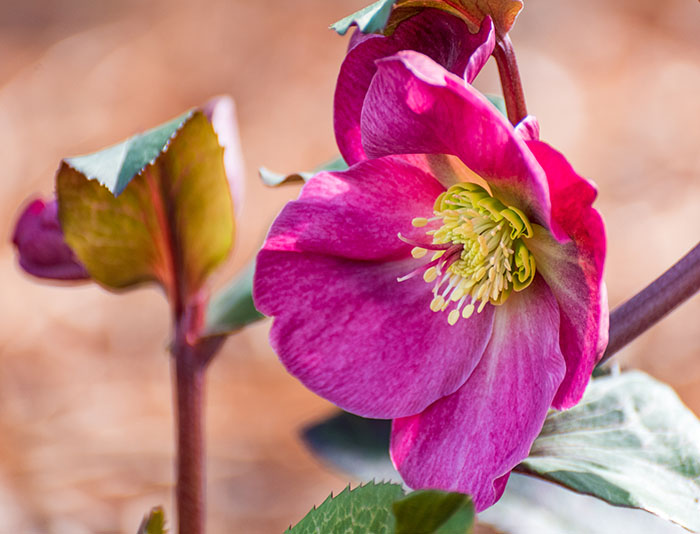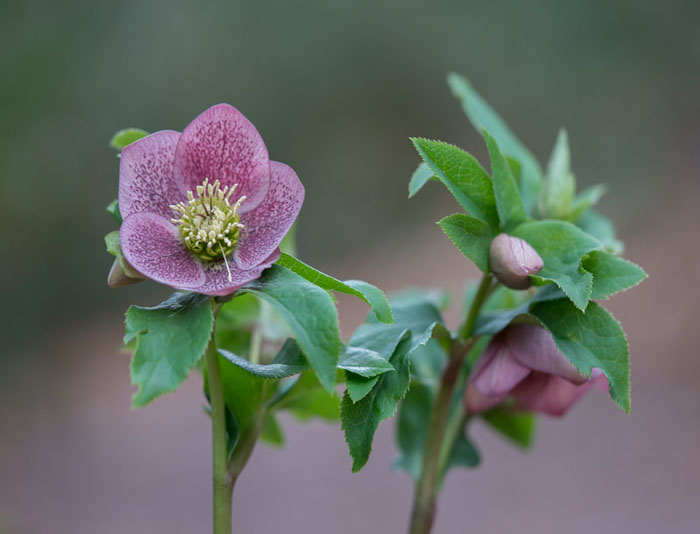Garden Talk
Horticultural Highlight: Hellebores
In this series, the staff of Duke Gardens highlights plants you’ll find within our 55-acre living collection. This week, marketing and communications assistant Katherine Hale discusses a winter-blooming favorite.
Botanical name: Helleborus × hybridus
Common name: Hellebores, Lenten roses
Family name: Ranunculaceae (Buttercup family)
Native range: Cultivated origin
Location in Duke Gardens: Historic Gardens, Doris Duke Center Gardens
USDA Hardiness Zones: 5-8
Despite their uncanny resemblance to their namesakes, Lenten roses or hellebores (Helleborus × hybridus) are rose imposters, lacking the thorns, fragrance and woody stems of true roses (Rosa sp). Closer inspection reveals that what appear to be colorful “petals” are actually sepals, or modified leaves, while the true petals are clustered at the flower’s center, offering nectar to visiting insect pollinators, much like their close relatives, the buttercups (Ranunculus spp.). While this distinction between petals and sepals may seem irrelevant to non-botanists, this evolutionary sleight of hand comes with deeply practical benefits for gardeners: hellebore sepals persist for months, long after the true petals have withered and the plant itself has gone to seed.

Native to Eurasia, wild hellebores have captured the human imagination for centuries, thanks to their seemingly miraculous tendency to bloom in the middle of winter—frequently overlapping with the Christian season of Lent. These low-growing evergreen perennials do best in shady woodland gardens or sheltered borders and edges, where their colorful blooms are easily visible. All parts of this plant are highly poisonous, which means they rarely suffer from the depredations of deer or other marauding mammals, and also that they should be kept away from any areas frequented by unsupervised young children.
There are a dizzying number of garden cultivars and interspecific crosses between various hellebore species, usually lumped together as H. × hybridus. To complicate identification even further, many nursery-grown plants billed as the common hellebore (H. orientalis) are actually mislabeled H. × hybridus individuals. Hybrid flowers range from solid green to white to pink to jet black, or a “picotee” combination of two or more colors, often with double or triple the number of sepals of the wild types. One particular favorite of Jason Holmes, curator of the Doris Duke Center Gardens’ extensive hellebore collection, is ‘Pink Ice', with its unique combination of gradually reddening bracts and marbled steely blue foliage with silver veins.
Because many hellebore flowers hang downward on their stalks, it can be challenging to display them to their best advantage in a vase. One common solution is to float each bloom face-up in a bowl of water, similarly to camellias or gardenias. Visitors to the Doris Duke Center in past years may recall a sampler of the many varieties of hellebores at the Gardens during peak bloom in late February and early March, offering a closer look at the wonders awaiting them outside. You’ll find them in abundance throughout both the Historic Gardens and the Doris Duke Center Gardens, most notably in the Memorial Garden, the Welch Woodland Garden, and the Page-Rollins White Garden.
Hellebore flowers lack scent, unlike roses, so you shouldn’t stop and smell them. Even so, it’s well worth the time to stop and appreciate this incredible winter bloomer in all its many permutations.
Photos from top to bottom: A hybrid hellebore in the Doris Duke Center Gardens, by Clarence Burke; hellebore blossoms on display in the Doris Duke Center, by Cathi Bodine; and H. × hybridus 'Anna's Red' in bloom in the Welch Woodland Garden, by Cathi Bodine.







